Tuesday Triage #37
- TUESDAY TRIAGE #37 by Vadim Drobinin
- On fast food
- Triple chili crisp
- KFC-inspired chicken
- Sweet Potato fries
- Donuts in coffee
- Things I enjoyed reading
- 1. Overnight Pizza and The Consistent Unreliability of Expert Guidelines by Resident Contrarian
- 2. Notes from a Moab Trailer by Mark Sundeen
- 3. The Solution of the Zodiac Killer’s 340-Character Cipher by Sam Blake
- 4. A Student Stole My Academic Work, Copied My Tattoos and Gave Talks Pretending To Be Me by Matt Lodder
- 5. Why English actually is relatively easy to learn (but not to master) by @christopherwink
- 6. Fundamentals of Optimal Code Style by Aleksandr Skobelev
- 7. The best frequently don’t rise to the top by Adam Zerner
- 8. Who owns England's woods? by @guyshrubsole
- 9. Printing In Virtual Reality: Part I by Elska Rós
- 10. The best minds of my generation are thinking about how to make people click ads—and that's ok by @brikis98
- Things I didn't know last Tuesday
- 1. Mikhail Saltykov-Shchedrin's surname
- 2. Coffee deficit in the world
- 3. Monument to 1300 Years of Bulgaria, Shumen
- 4. Schiphol fly
- 5. Wine after a year in space
- 6. Hitchhiking in Cuba
- 7. Peanuts are not nuts
- 8. US Congress' bootlegger
- 9. Kintsugi
- 10. Ice-cream toothache
- Book of the week
- Thank you and see you in a week!
TUESDAY TRIAGE #37
by Vadim Drobinin ¶
Your weekly crème de la crème of the Internet is here!
30.03.2021 (read in browser)
On fast food ¶
I am quite reluctant to use the word "junk" when it comes to food.
Some dishes are healthier than other, but a nutritional value is not the main benefit for most (trust me, I tried to survive by consuming only a British equivalent to Soylent, called Huel).
This week I indulged myself by cooking some of those not-too-healthy-but-quite-entertaining-technique-wise ones.
And it was delicious, obviously.
Triple chili crisp ¶
Fast food goes great with spicy sauces. This one is a mix of four different peppers, including angels hair:
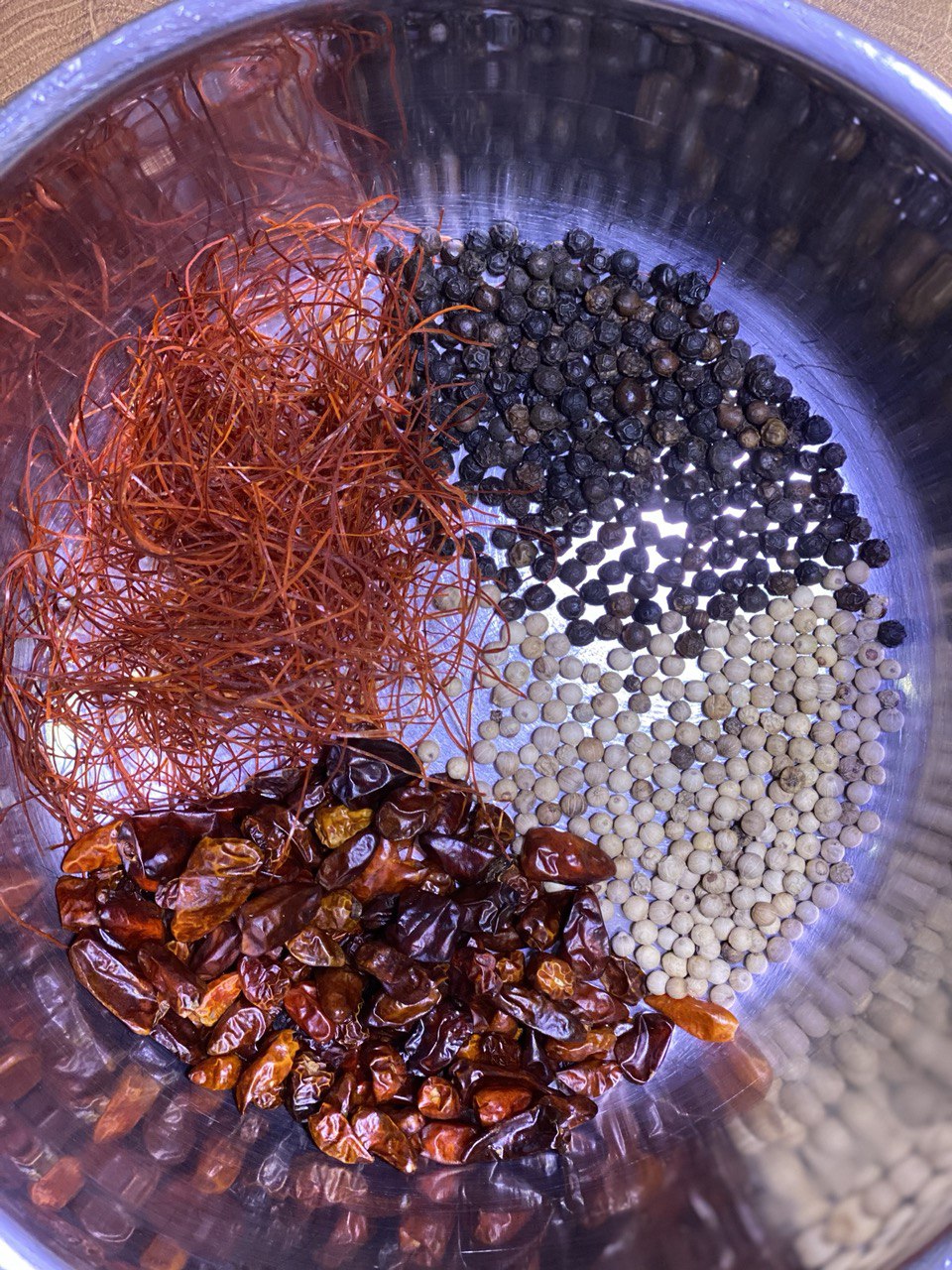
Which was infused into oil and mixed with shallots, garlic, and peanuts:
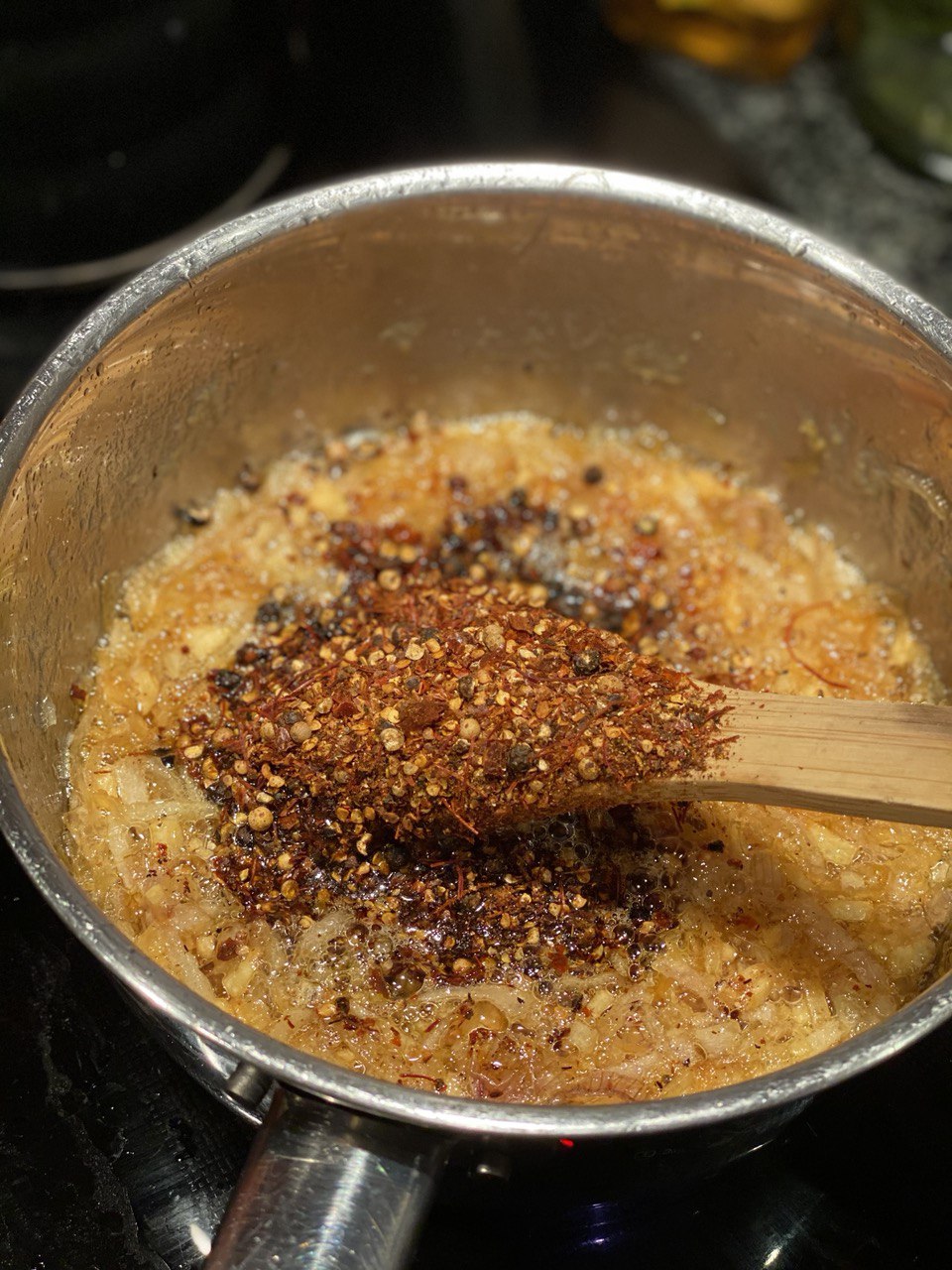
I made a smaller batch, diluted with some honey and malic acid, but honestly prefer the plain version. Think of it as an odd mix between Chinese chili crisps and Nashville hot chicken sauce, but better.
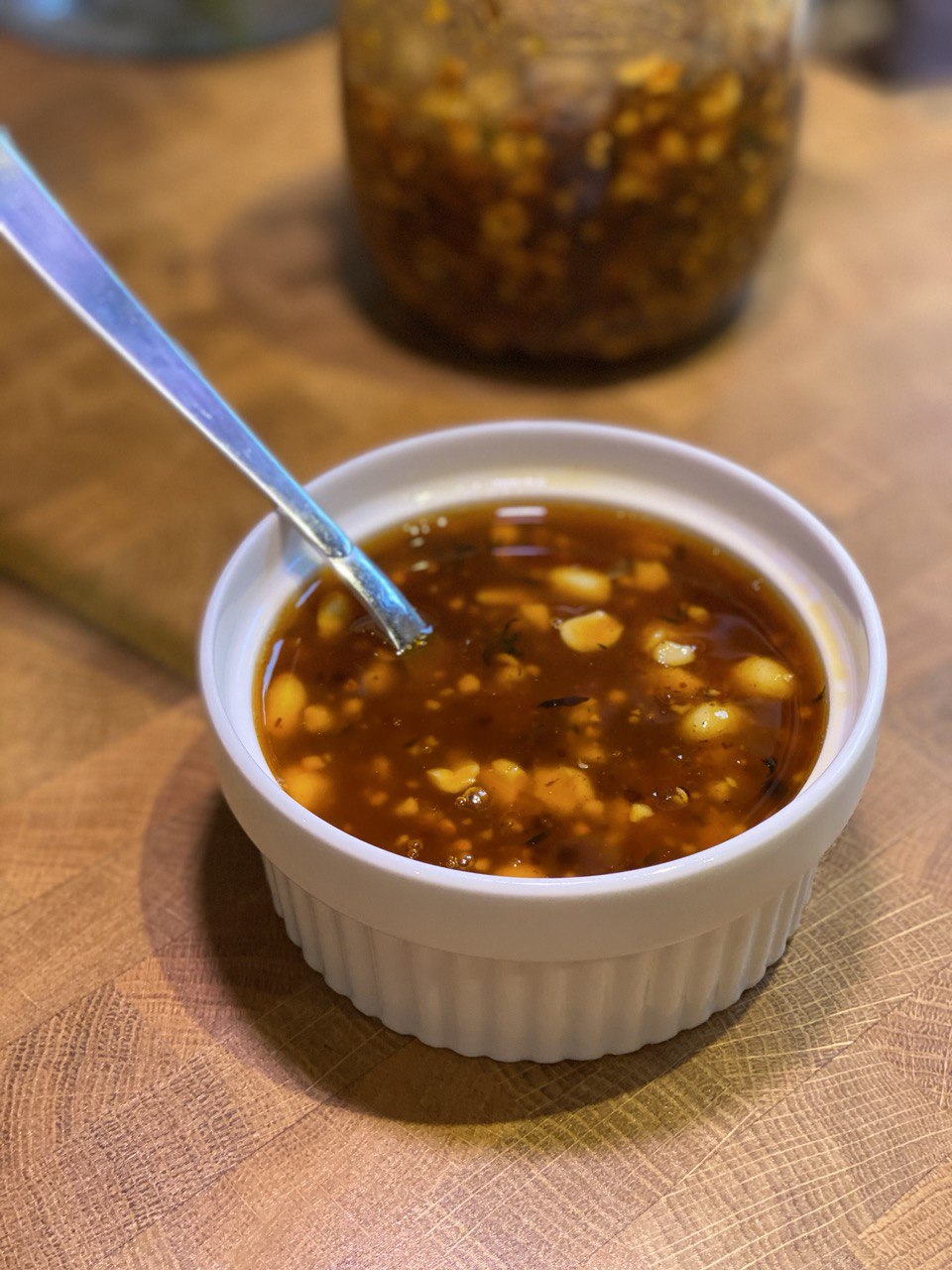
KFC-inspired chicken ¶
That's a funny one.
I love KFC, and yet I hate food with bones, so always struggle with wings, ribs, and so on.
Here I had the freedom of cooking a few kilograms of boneless pieces which is precisely what I did.
Cooked to perfection in sous vide, breaded, marinated in buttermilk, and breaded again, it already looks good.
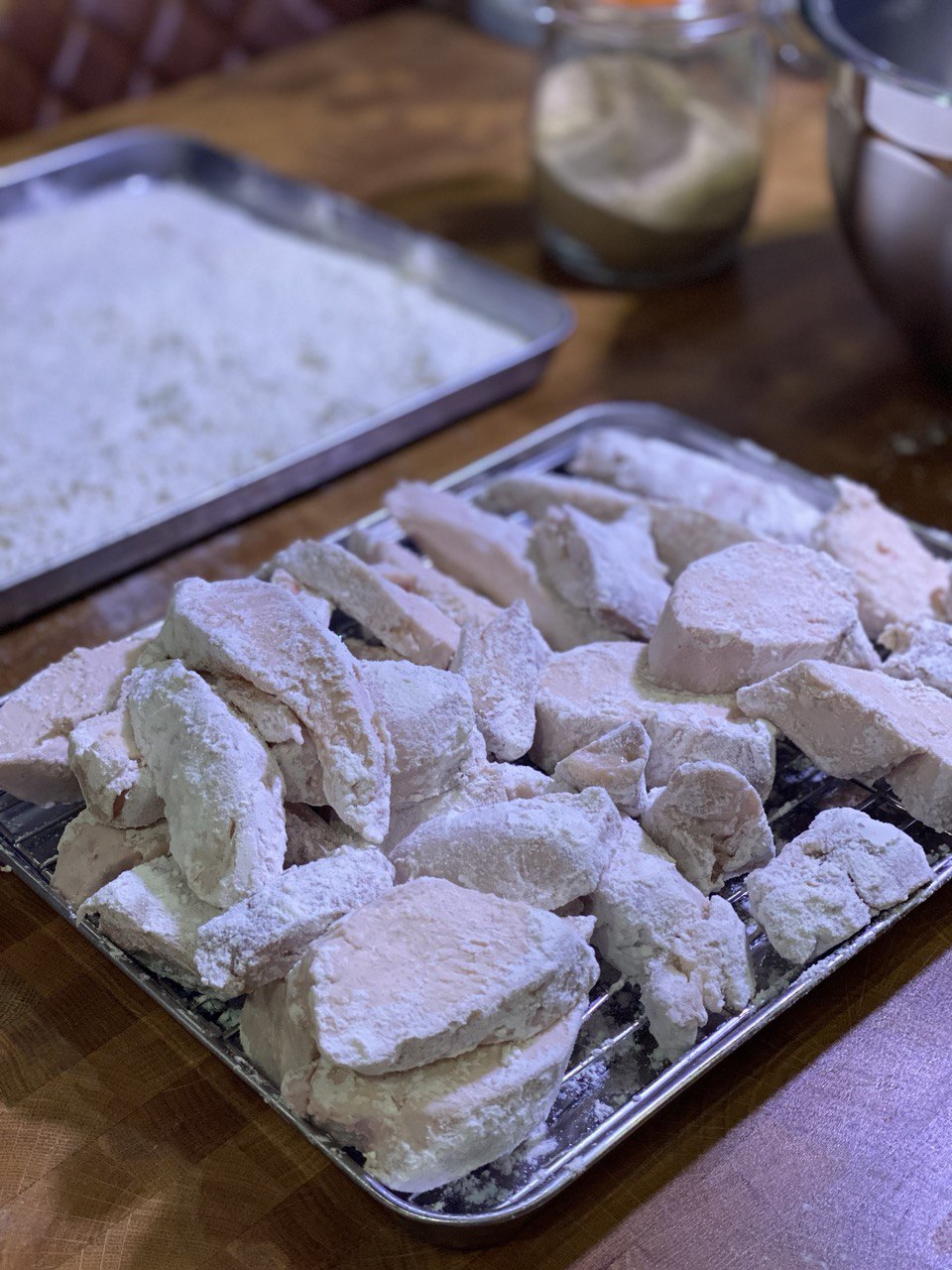
Briefly deep fried, as it was already cooked, it got even better.

I sprinkled on top a bunch of KFC-inspired spices (a plenty of very similar recipes in the Internet, mostly peppercorns and herbs) and then kept in a dehydrater to prevent from getting soggy.
Sweet Potato fries ¶
Quite a few chefs I respect a lot think of sweet potato fries quite poorly (looking at you, Dave Arnold).
I think partly because many try to approach a completely different vegetable the same way they approach ordinary potatoes, which doesn't work as there is pretty much no starch in sweet potatoes, and as many places just keep doing that, they end up with very soft pieces, which is less than ideal.
I did too much research to give up, so ended up boiling them, dehydrating to get rid of moisture, and then re-hydrating with a starch slurry instead.

It wasn't superb, but it was definitely better than I expected, and way better than in many places I've been to. Learning how to make a DIY fries box was quite fun too.
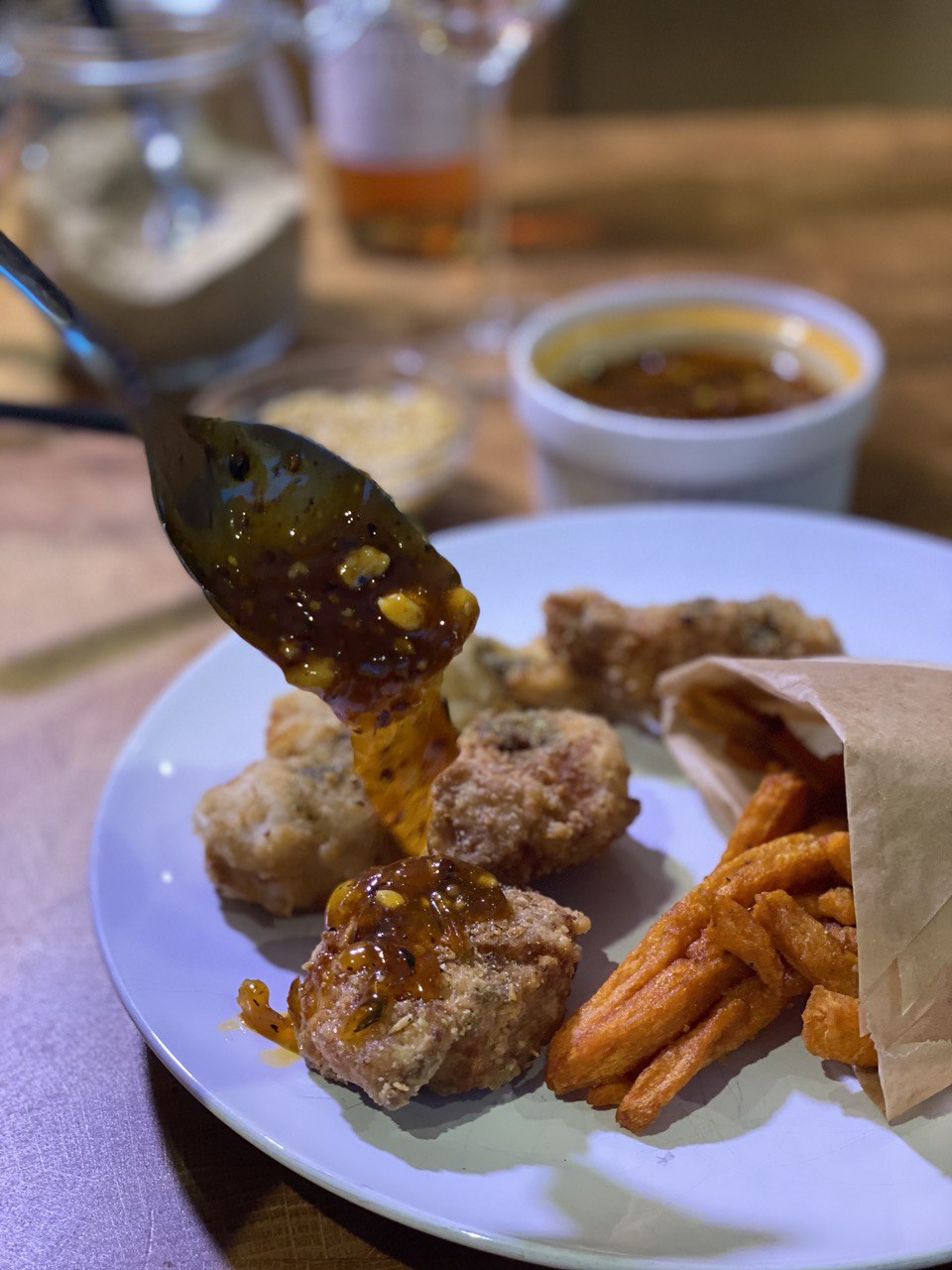
Donuts in coffee ¶
And then I went even further into the cooking fast food abyss and infused milk with Krispy Kreme donuts:
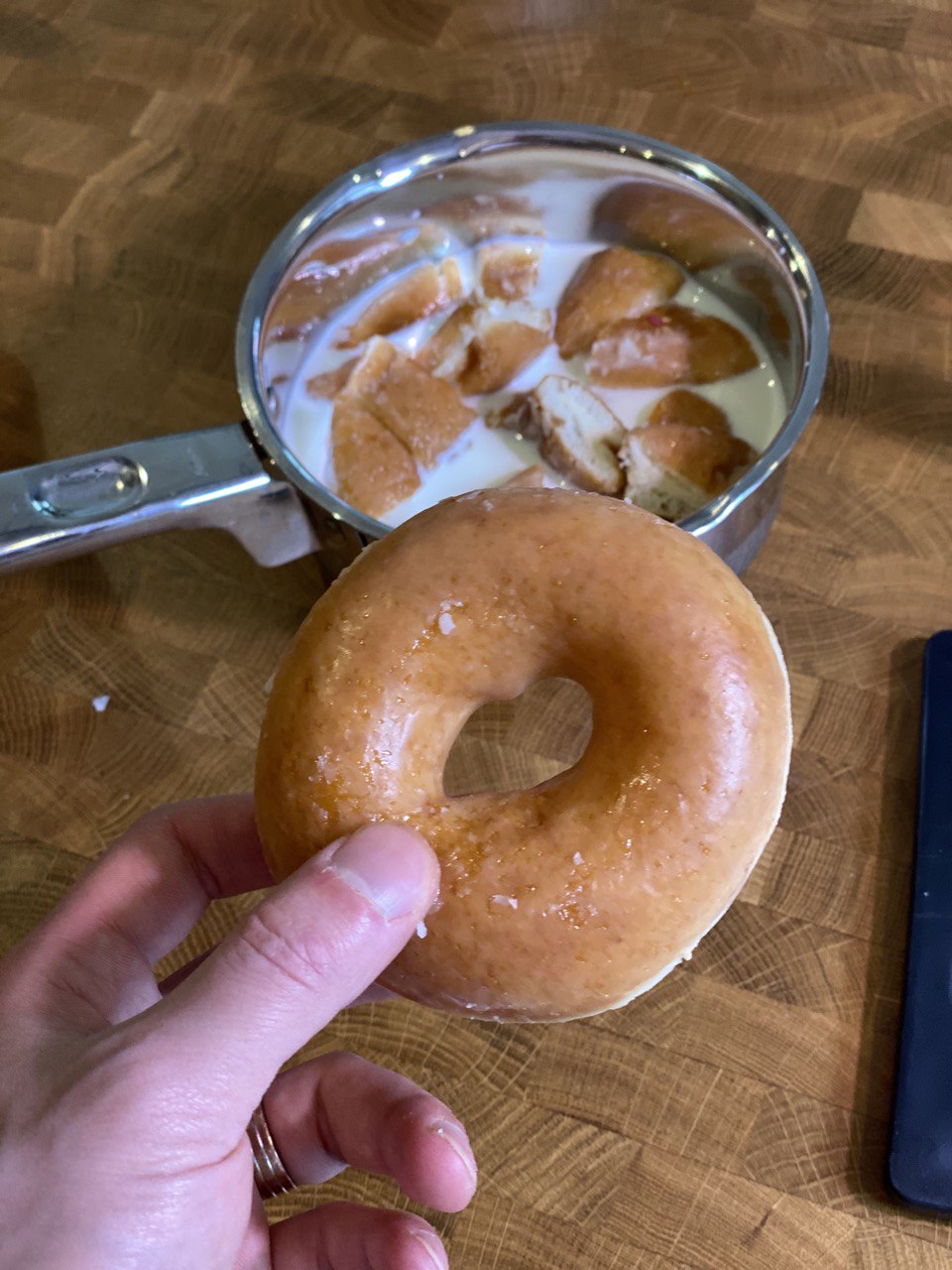
Which was then textured, and added to freshly pulled shots of single origin espresso.
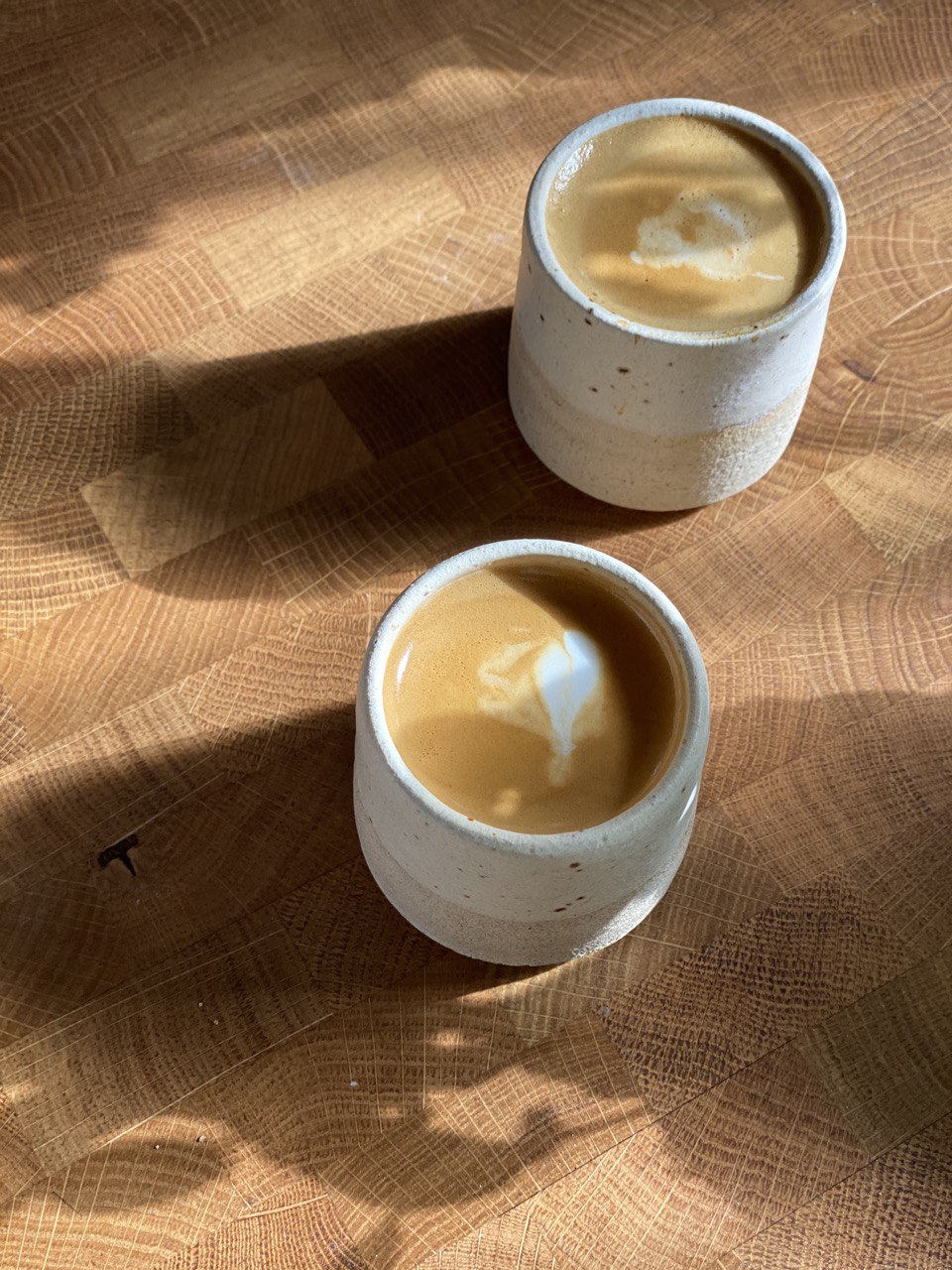
The outcome is quite questionable, but this cortado does taste like donuts... and I don't particularly like that the taste is so prominent.
Was it fun? Yes.
Would I drink it again? Hopefully no.
Things I enjoyed reading ¶
1. Overnight Pizza and The Consistent Unreliability of Expert Guidelines by Resident Contrarian ¶
A few weeks ago I've mentioned water activity which explains why some food goes bad faster than the other, and this is a very good essay on dangers of both leaving a pizza overnight on a counter and blindly following the government guidelines.
Note that the USDA’s standard here is much, much harsher than “overnight”; any food that’s been out more than two hours has to be chucked. Thus if you or Conor have ever had any guest go back at 8:00 PM for a second slice of a pizza that arrived at 6:00 PM and didn’t slap it out of his hand, you and he stood just as much in defiance of the USDA’s guidelines for this sort of thing as any overnight-pizza eater.
In that sense the less one knows the happier they leave, as personally I think through all risks and then consciously go ahead pretty much every day, whether it's cooking a tartare steak or mixing a cocktail with raw egg white.
These are the risks worth taking though, it doesn't work the same way with overnight pizza.
2. Notes from a Moab Trailer by Mark Sundeen ¶
A somewhat sad and yet motivational story about living in a trailer for two decades, which might sound extreme but actually seems to be not too bad once you have a decent piece of land and access to nearby cities.
I needed the truck to be independent—I often slept in it, reading the fat hardbacks of Leo Tolstoy and George Eliot by headlamp—but felt like a spoiled shit because my parents bought it for me, even as I justified this with the fact that they had just inherited some money after the deaths of three grandparents. Driving the truck to Utah after buying it in L.A., I bought snow chains at a gas station at the base of a pass. I wanted to be the sort of man who is competent with chains and repairs, rough roads and icy curves, but I still saw myself as a child riding a skateboard on the smooth asphalt of sunny subdivisions.
3. The Solution of the Zodiac Killer’s 340-Character Cipher by Sam Blake ¶
I really liked this step-by-step explanation on cracking one of the most stable ciphers in the modern history of cryptography.
Fifty-one years after the Zodiac Killer mailed this cipher to the San Francisco Chronicle, we had a solution. David submitted this solution to the FBI Cryptanalysis and Racketeering Records Unit (CRRU) on Saturday, December 5, 2020. Shortly after, the FBI was able to officially confirm the validity of our solution.
4. A Student Stole My Academic Work, Copied My Tattoos and Gave Talks Pretending To Be Me by Matt Lodder ¶
This one is actually quite creepy: imagine someone making the same tattoes as you have and then traveling to conferences pretending to be you.
He told his tutors he was in London, giving all these talks and speaking at conferences that in reality I was speaking at. For his assignments, he handed in my work with minor to no edits or additions. An article I wrote for a magazine, that he simply added footnotes to and submitted as part of his degree, was marked at 90 percent, as I later came to know. Well, at least that was a major ego boost.
Right, now I have a new fobia.
5. Why English actually is relatively easy to learn (but not to master) by @christopherwink ¶
An interesting way to explain the unusual parts of English the language in the form of notes to a book focused on the untold story of its past.
Vikings are why we don’t have many verb conjugation endings, as McWhorter argues that Norsemen married English isle-native women and, as whenever many adults are learning a language non-natively, it gets simpler.
I probably should look up the book too, sounds like a decent read.
6. Fundamentals of Optimal Code Style by Aleksandr Skobelev ¶
Code style is something that should have been resolved years back, and yet people still argue on best practices.
This one is actually a great deep dive into the history and the way people read, as code style is meant to simplify the reading process itself:
Therefore, when talking about optimizing the text of a program, it makes sense to talk only about the objective component of readability, and therefore further in this article, the term readability will always refer to this component of it.
7. The best frequently don’t rise to the top by Adam Zerner ¶
Mostly just exploring an idea without any specific solutions, but I tend to agree. Lots of people might be really good (or even tremendously good) at something, but not all of them actually become known to the rest.
I spent over five years working on two separate startups that both failed pretty miserably. And in both cases, I felt like the market wasn’t very fair to me. I felt like I had pretty good quality products, and that my level of success was not even close to proportionate to the quality I produced. Well, not just the quality of the product, I’m trying to talk about product + marketing + everything else.
While I don't have a solution either, I distinguish between "celebrity fame" (that's when people recognise you on the streets) and "niche fame", where you are recognised within small but influentual circles.
We can always optimise our decisions to achieve one or the other, and the latter is definitely hard.
8. Who owns England's woods? by @guyshrubsole ¶
An unexpected research on woodland ownership, which I stumbled up some time ago while looking up places where foraging is legal (which is harder to find than I though!).
Given the strategic importance of timber in English history, it’s perhaps a bit surprising that there hasn’t been a proper national analysis of woodland ownership. The indefatigable Andy Wightman has researched forest ownership in Scotland, but no-one appears to have done a similar study for England.
9. Printing In Virtual Reality: Part I by Elska Rós ¶
This is a quite specific but really well-written tutorial on printing images in VR, with some very self-explanatory Python code. It might feel niche, but in a few years will be way more common.
To make this article a reasonable size, we will focus on a two simple primitives first then in future articles we will get more advanced. For now we will make pixels and voxels! I think we all know what pixels are, but a voxel is a cuboid, its a pixel for 3-dimensions.
10. The best minds of my generation are thinking about how to make people click ads—and that's ok by @brikis98 ¶
A nice way to explain why so many engineers seem to do random things instead of curing cancer and saving the world.
Many mathematicians prefer problems that are beautiful to those that are useful. Despite that, mathematics has been the basis for countless discoveries of immense practical value: physicists, chemists, engineers, programmers, and countless others use math on a daily basis to build all the tools and technology of modern society.
On that note, those fancying saving the world could start by writing energy-efficient code (here are some good talks on the topic) and as a result fight global warming.
Things I didn't know last Tuesday ¶
1. Mikhail Saltykov-Shchedrin's surname ¶
I grew up reading his books just to learn that in fact the surname was created way after the author's death.
His original surname was Saltykov. This was later combined with the surname from his pseudonym Nikolai Shchedrin.
So Mikhail Saltykov was using a pseudonym and never though that two centuries later people will start calling him altykov-Shchedrin.
2. Coffee deficit in the world ¶
Who would think that some stuck containers could cause such an issue?
Coffee stockpiles have sunk to a six-year low in the U.S. even with Brazil’s record crop, and a large drop in output after a drought in the South American country is expected to shift the world balance to a deficit in coming months just as demand rebounds.
Off I go to stock up on coffee beans before it is too late.
Last time it happened with vanilla pods, just saying.
3. Monument to 1300 Years of Bulgaria, Shumen ¶
Look at that beauty.

It stands at a height of 450 m above sea level and can be seen from 30 km away.
4. Schiphol fly ¶
A brief intro to behavioral science applied in Schiphol airport:
It turns out that men, in their urinal behaviour, cannot resist peeing on things, especially if they look as though they might wash away.

5. Wine after a year in space ¶
Some folks sent one of the most expensive bottles in the world to space and then tried it.
"They were both absolutely gorgeous, but again following the color, the one that had remained on Earth for me was still a bit more closed, a bit more tannic, a bit younger. And the one that had been up into space, the tannins had softened, the side of more floral aromatics came out. They were both beautiful. The one that had remained on Earth was a little younger than the one that had been to space," she says.
Apparently it got better. Does it work with food too?
6. Hitchhiking in Cuba ¶
In Cuba, picking up hitchhikers is mandatory for government vehicles, if passenger space is available:
A government worker stands at the punto amarillo, asks where you're going, takes .25 Cuban pesos, (about 5 cents), and flags down a government vehicle heading that direction. The vehicles are legally required to stop if people are waiting.
That's actually quite neat.
7. Peanuts are not nuts ¶
OK, I didn't expect that.
Like soybeans, lentils, and other legumes, peanuts are edible seeds that grow in pods. Still, most people think of them as nuts, along with tree nuts such as walnuts, almonds, and hazelnuts.
What's next, tomatoes are actually fruits? Avocados are berries? Or maybe watermelons are vegetables?
8. US Congress' bootlegger ¶
During Prohibition, the US Congress had their own alcohol bootlegger delivering 25 orders per day to a private storeroom in the basement of the House Office so he could avoid the Capitol Police.
At some point he was arrested but just changed the building:
Undeterred by his setback, Cassiday switched his business to supplying booze to the Senate Office Building. In 1930, he was arrested delivering six bottles of gin to the senators’ parking lot and forced to give up his client book.
Years later the Senate named a restaurant after him.
The legend.
9. Kintsugi ¶
There is a Japanese (of course it is Japanese) art of repairing pottery that highlights the cracks with powdered precious metals.
As a philosophy, it treats breakage and repair as part of the history of an object, rather than something to disguise.
10. Ice-cream toothache ¶
Ah, finally the explanation, which seems to be way less magical than I thought it would be:
They have located the cells and signals in sensitive teeth that detect big temperature drops and trigger toothache and brain jolt.
Book of the week ¶
Some time ago I mentioned my experience with the most recent Harold McGee's book, Nose Dive, which I didn't enjoy as much as I hoped, for it was too odd and not useful enough in the practical sense of this word.
I didn't give up searching for a decent book on the science behind smells, and I think I have finally found the one I can recommend, thanks to Paolo Pelosi's On the Scent.
It builds up on a few things, the main one being an understanding that for many people chemistry is not the most appealing subject, and then slowly teaching how it could be changed not through formulas and charts, but emotions and sensations, flower scents, spice odours, and so on:
We then proceed along the street, increasing the number of carbon atoms, but retaining the alcohol group at the end of the chain: the odour is still green in character, but a citrus note appears, particularly in members with between nine and 10 carbon atoms. Make the chain even longer and a floral scent becomes noticeable in undecanol and dodecanol. Then, with further additions to the chain, the odour gets weaker and less characteristic. So let’s go back and take a parallel street where we meet the family of aldehydes...
Despite the author being a chemist by trade, I am pretty sure professional chemists might find the book to be inaccurate at times.
Its chapter on smell and taste interaction is too short to be useful to chefs.
It mentions alcohol a lot, but mostly as a way to carry the molecules, and while I will definitely use a lot from it to build new drinks, I doubt that was the main goal of the writer.
All in all, I am still not sure who it was written for, but it's definitely good.
Thank you and see you in a week! ¶
If you have any questions, or want to suggest a link for the next newsletter, please drop me a message on Twitter or reply to this email.
Cheers! 🍸